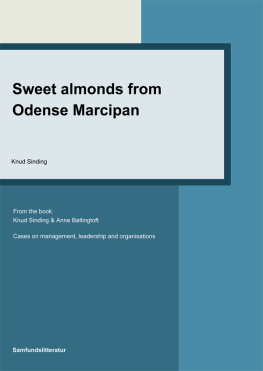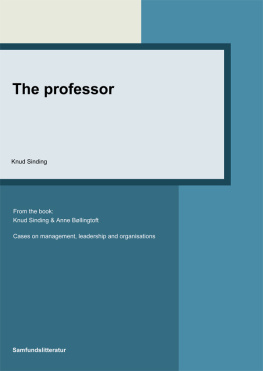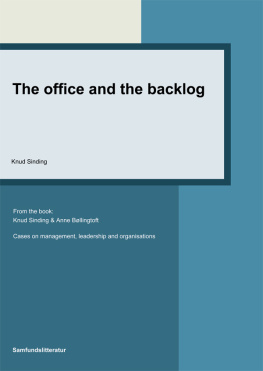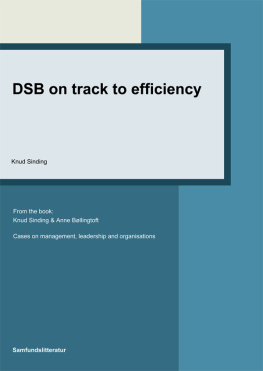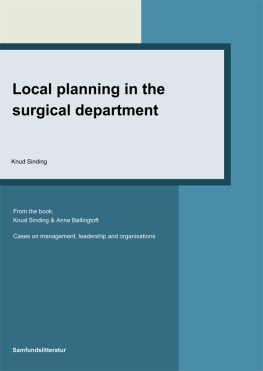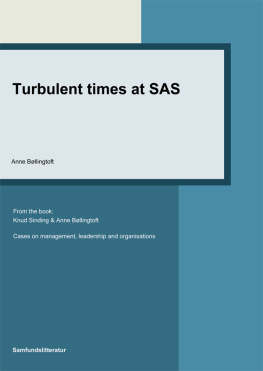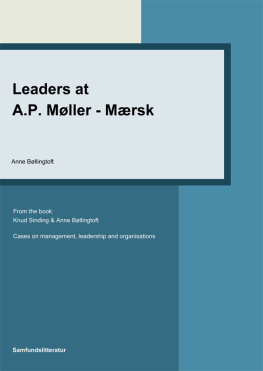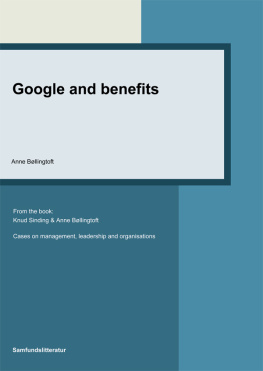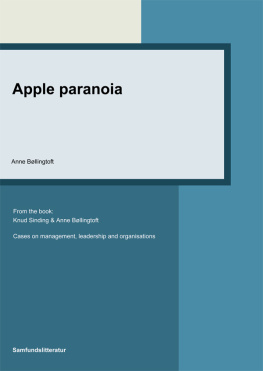Sinding - Sweet almonds from Odense Marcipan Cases on Management, Leadership and Organisations
Here you can read online Sinding - Sweet almonds from Odense Marcipan Cases on Management, Leadership and Organisations full text of the book (entire story) in english for free. Download pdf and epub, get meaning, cover and reviews about this ebook. City: Samfundslitteratur, year: 2013, publisher: Knud Sinding, Samfundslitteratur, genre: Business. Description of the work, (preface) as well as reviews are available. Best literature library LitArk.com created for fans of good reading and offers a wide selection of genres:
Romance novel
Science fiction
Adventure
Detective
Science
History
Home and family
Prose
Art
Politics
Computer
Non-fiction
Religion
Business
Children
Humor
Choose a favorite category and find really read worthwhile books. Enjoy immersion in the world of imagination, feel the emotions of the characters or learn something new for yourself, make an fascinating discovery.
Sweet almonds from Odense Marcipan Cases on Management, Leadership and Organisations: summary, description and annotation
We offer to read an annotation, description, summary or preface (depends on what the author of the book "Sweet almonds from Odense Marcipan Cases on Management, Leadership and Organisations" wrote himself). If you haven't found the necessary information about the book — write in the comments, we will try to find it.
Sweet almonds from Odense Marcipan Cases on Management, Leadership and Organisations — read online for free the complete book (whole text) full work
Below is the text of the book, divided by pages. System saving the place of the last page read, allows you to conveniently read the book "Sweet almonds from Odense Marcipan Cases on Management, Leadership and Organisations" online for free, without having to search again every time where you left off. Put a bookmark, and you can go to the page where you finished reading at any time.
Font size:
Interval:
Bookmark:
Knud Sinding
Sweet almonds from Odense Marcipan

Knud Sinding
Sweet almonds from Odense Marcipan
From the book:
Knud Sinding and Anne Bllingtoft
Cases on Management, Leadership and Organisations, 1st edition 2012, chapter 5
1st e-book chapter 2013
Samfundslitteratur 2012
Cover design: Klahr|Graphic Design
Typeset: SL grafik, Frederiksberg
E-book production: Rosendahls BookPartnerMedia
ISBN: 978-87-593-9540-0
Samfundslitteratur
Rosenoerns All 9
DK-1970 Frederiksberg C
Denmark
Tlf: + 45 38 15 38 80
Fax: + 45 35 35 78 22
www.samfundslitteratur.dk
All rights reserved.
No part of this publication may be reproduced or used in any form or by any means graphic, electronic or mechanical including photocopying, recording, taping or information storage or retrieval system without permission in writing from the publisher.
CHAPTER 5
SWEET ALMONDS FROM ODENSE MARCIPAN
Sometimes managerial decisions seem to be based on careful analysis. Sometimes, however, they seem superficial, ill-conceived or downright silly. Some managers are focused on getting the best out of people while others are convention-bound, or want change for its own sake or both even if what they do isnt appropriate or implies stubborn disregard for facts.
Every single year, Danes eat tons of marzipan, especially at Christmas. Odense Marcipan produces a large portion of this. What few people think of when they eat the sweets is that hard work and sometimes interesting management goes into making the delicious marzipan.
Odense Marcipan is basically a traditional manufacturing company, which converts almonds, sugar, chocolate and various additives into finished or semi-finished products. For this case, its enough to know that there is plenty of monotonous factory work involved, also known as repetitive strain work in descriptions of physical work environment. Repetitive strain work is a problem because endless repetitions of the same movements can lead to degeneration of joints and muscles.
This tale of Odense Marcipan begins in 1994 at a time when autonomous work groups were just introduced. At irregular intervals, we get glimpses of events of the subsequent ten years. It is good to keep the length of this period in mind when discussing what happens along the way.
Odense Marcipan is over 100 years old. The first many years, the company grew slowly, but from the 1950s it advanced a little faster. Marzipan was supplemented with nougat produced from hazelnuts. Later in the 1960s and 1970s, the companys experience with nuts proved useful for the new KiMS Snacks (salted peanuts and the like).
In 1991, the company was taken over by the Norwegian conglomerate ORKLA. KiMS, and everything that had to do with snacks, was transferred to a separate company. Throughout the 1990s, production of sweets in Odense was consolidated, and in the following decade additional companies in the same and adjacent branches were acquired (the Swedish KK, Bchs Konditori, Marcia and Italian Natural Food).
In 2010, the total turnover was 325 million Danish Kroner, which gave a profit of 13 million Danish Kroner. Maybe not very impressive, but management thought it was a decent profit in a time of financial crisis.
Autonomous teams 1994
People who are growing create growth in businesses.
This was the philosophy Odense Marcipan chose as the basis for its production. This was one of the reasons why, around 1990, management focused mainly on personal development of each of the 210 people who were employed at that time. The manager of the factory, Brge Pedersen explained:
The personal factor is the futures most important competitive parameter. We wish to create a working place where people can develop and grow. There are many hidden resources within the employees and we need to make sure these flourish. My claim is that if we keep telling employees what they need to do and when, then we will only reap the benefits of about a quarter of their creative abilities. The rest isnt utilised. And thats foolish.
With the introduction of the autonomous work teams in 1994, he had been employed at Odense Marcipan for 20 years. He had been there since the first tentative steps towards creating a more people-friendly and competitive operation were made back in 1980.
Long process
The changes at Odense Marcipan began with the introduction of rotation schemes and training of employees. This coincided with the modernisation of the company, where a range of new machines was installed. But it didnt happen easily.
There was a lot of resistance among the employees. Most of them didnt want to be trained nor did they want rotation. To help change this, we introduced a new pay scheme. The more machines an employee could service, the higher the hourly pay. And the same principle was applied to the training. When an employee returned from a course, their pay increased automatically.
This is how Brge Pedersen explained it. At the same time, he confirmed that higher pay alone isnt sufficiently motivating, but in a transition period during which attitudes and culture were being adapted, pay was a fine incentive.
Change is costly
Around 1990, the company also began looking more closely at the management structure. The previous bureaucratic management system, organising employees and management into four levels, was completely broken down. Only two levels remained, and managements role was completely different from earlier; it was mainly meant to inspire and inform.
In January 1994, the company took the final steps in introducing autonomous groups throughout the company. Brge Pedersen explained that it was due to changes in the market.
We had more competitors, both at home and abroad. The prices of our products fell, and growth was stagnant. We could see that the key to success was in the desire to bring about change. As a consequence, we chose to create change while the company was still doing well. It has clearly been an advantage. Change and reorganisation require big investments, especially for training, but that money can be hard to find once a business begins to run poorly.
Employee equality
Allan Bgh, the 23-year-old union representative in 1994, had nothing but praise for the direction, management had outlined. He saw no contradiction between management and employees objectives, and therefore did what he could to break down prejudices against personal development amongst his colleagues:
Just in the course of the five years I have been here, all the limits have moved quite a bit. Through training and development courses, we have learned to cooperate across the board. And we have learned to communicate with management. When I started here, lots of employees didnt dare open their mouths if Brge was there. Its not like that anymore. Everybody feels equal. It has also meant that my role has changed. Now many employees go directly to Brge with problems that they would have asked me to talk to him about before. Brge probably sees everything through more financial eyes than I do, but we are in total agreement about the basic attitudes. If we had refused to cooperate on this, the company would have gone down. And nobody would benefit from that.
Energies unleashed
All employees went through a week-long course in quality and spent a week on a personal development course. In addition, employees participated in a large number of individual courses, for both professional and personal development and seminars on occupational health and working environment. A special visualisation seminar for all employees was one of the many events that really moved boundaries. Allan Bgh described the change:
Next pageFont size:
Interval:
Bookmark:
Similar books «Sweet almonds from Odense Marcipan Cases on Management, Leadership and Organisations»
Look at similar books to Sweet almonds from Odense Marcipan Cases on Management, Leadership and Organisations. We have selected literature similar in name and meaning in the hope of providing readers with more options to find new, interesting, not yet read works.
Discussion, reviews of the book Sweet almonds from Odense Marcipan Cases on Management, Leadership and Organisations and just readers' own opinions. Leave your comments, write what you think about the work, its meaning or the main characters. Specify what exactly you liked and what you didn't like, and why you think so.

